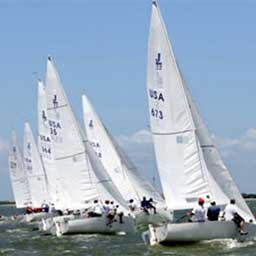The Basic Keelboat graduate will have successfully demonstrated the ability to responsibly skipper and crew a simple daysailing keelboat in familiar waters in light to moderate wind and sea conditions.
Recommended Equipment: It is recommended that Basic Keelboat Certification courses and examinations be conducted on 18′ to 27′ daysailing sloop-rigged keelboats with tiller steering and with adequate equipment inventory to complete all required certification outcomes.
Prerequisite: In most cases, there is no prerequisite for taking the US Sailing Basic Keelboat Certification course. Individual schools may add specific pre-course work to be completed before taking the Basic Keelboat Certification course. Check with your school to see if they have any pre-course requirements.
Certification Requirements: Basic Keelboat Certification requires successfully completing the following knowledge and skill requirements. These requirements are expected to be performed safely with confident command of the boat in familiar waters with a wind range of 5 to 15 knots. Some regions may have stronger prevailing conditions, which are acceptable if the candidate can safely control the boat and be aware of his or her limitations. The certified candidate will be able to skipper a tiller-steered keelboat up to 27 feet in length.
Is chartering a yacht your dream vacation, but don't know where to start? Try US Sailing's Basic Keelboat course! Learn more about how getting your basic keelboat certification can start your chartering journey in this video with US Sailing partner The Moorings.
Practical Skills
Preparation to Sail:
- Demonstrate the ability to recognize and forecast prevailing local weather conditions.
- Demonstrate how to properly board a boat.
- Perform a presail check for the boat’s flotation integrity, safety and legally required equipment, and crew indoctrination.
- Demonstrate the proper rigging of the sails, halyards, sheets, blocks, and winches.
- Check all other equipment specific to your boat not indicated above.
Crew Operations and Skills:
- Demonstrate how to put on a life jacket.
- Demonstrate tying and use of knots: stopper knot, bowline, cleat hitch and a square knot.
- Demonstrate the use of these sail controls: halyards, sheets, Cunningham/downhaul, and outhaul.
Leaving the Dock or Mooring
- Demonstrate appropriate helmsman and crew coordination and skills for departure suitable to the conditions: raising sails, line handling, casting off and boathandling.
Boat Control in Confined Waters:
- Demonstrate in close quarters under sail: starting, stopping, speed control, tacking, jibing, steering control, sail luffing, the No-Go Zone, getting out of irons, backing the jib, and crew coordination and communication.
- Demonstrate sailing a predetermined closed course and maneuvering around obstacles.
Navigation:
- Point out Aids to Navigation in the harbor and local waters that you are sailing, and respond accordingly.
Navigation Rules, International-Inland:
- Demonstrate the use of Navigation Rules while sailing.
Boat Control in Open Water:
- Demonstrate proper sail trim with accurate sheet adjustment of the main and headsails. Make use of the sail telltales and identify points of sail.
- Perform a heaving-to maneuver.
- When appropriate, demonstrate sailing “by the lee” and explain the inherent dangers involved.
Heavy Weather Sailing:
- Demonstrate how to reef and/or depower sails.
Overboard Rescue Methods:
- Properly demonstrate one of the overboard rescue methods, which is most appropriate for your sailing ability, boat type, crew experience, wind and sea conditions, and maintaining constant visual contact with the person in water.
Safety and Emergency Procedures:
- Explain the proper procedure for using an approved distress signal.
Returning to the Dock or Mooring:
- Demonstrate appropriate helmsman and crew coordination and skills for arrival under sail and/or power suitable to the conditions: boathandling, deploying fenders, stopping, tying up and lowering sails. Explain at least two different approach plans for other conditions.
- Demonstrate stowing of sails, rigging, and equipment. Thoroughly clean the boat, and install any covers.
- Check both the electrical and bilge systems for dock operation if required.
- Check the locks on companionway, lockers, and hatches. Make a final check of docklines, spring lines, and fender placement.
Knowledge
Preparation to Sail:
- Describe personal preparation such as clothing and sun protection.
Crew Operations and Skills:
- Be familiar with the nomenclature for basic parts of the boat, sails, battens, and rigging.
- Describe the proper use of life jackets and throwable flotation devices.
- Describe the use of sail controls.
- Explain potential electrical hazards such as overhead electrical wires and lightning.
Sailing Theory:
- Describe basic sailboat design, sail theory, and boat dynamics.
- Explain how to read the wind and determine all points of sail.
- Understand what is meant by the term “sailing by the lee” and explain the inherent dangers involved.
Leaving the Dock or Mooring:
- Understand the effects of wind, tide and currents in relation to the boat and surrounding area while preparing to get underway.
- Describe the differences and alternatives for leaving under sail and/or power in upwind, crosswind and downwind situations.
Navigation:
- Be familiar with basic chart reading specific to your local waters.
- Describe Aids to Navigation: buoys, daymarks, regulatory markers, and other markers specific to your local waters.
Navigation Rules, International-Inland:
- Describe the Navigation Rules, International-Inland, for Stand-On and Give-Way sailboats and powerboats for collision avoidance and understand your state and local boating regulations.
Heavy Weather Sailing:
- Describe weather warning sources.
Overboard Rescue Methods:
- Understand the Quick-Stop and Figure-8 overboard rescue methods to include: constant visual contact with the person in water, communication, rescue plan, sequence of maneuvers, boathandling, course sailed, pickup approach and coming alongside the person in water (or simulated object).
- Describe methods of getting a person in water on deck.
Safety and Emergency Procedures:
- Be familiar with the treatment of overheating, hypothermia and seasickness.
- Describe the use and regulations for flares.
- Be familiar with at least six different distress and emergency signals per Navigation Rule 37.
- Be familiar with the U.S. Coast Guard requirements for safety equipment.
Anchoring Techniques:
- Be familiar with anchoring procedures for emergency situations such as loss of boat control, sudden storms, prevention from going aground or injured crew situations.
Returning to the Dock or Mooring:
- Describe the differences and alternatives for arrival under sail and/or power in upwind, crosswind and downwind situations.
Challenge a Course
If you are an experienced sailor, you may also challenge a course to achieve the desired level. The US Sailing Keelboat Certification System is a series of sailing levels based on the natural progression of experience from daysailing to cruising and then extended passage making.
A certification candidate may, with extensive previous experience and competency, challenge the required prerequisite levels by completing the written and practical examinations for each required level. Essentially, you will undergo an on-the-water check-out for the highest level of certification you are challenging. Pass the practical and then take the exam for the appropriate certification levels.
An example is that you wish to challenge the Bareboat Cruising Certification. You are taken for an on-the-water check-out at the bareboat cruising level to ensure you possess the skill sets we expect our students to have at that level. Pass the practical exam, and then you will take the multiple-choice exams at the basic keelboat, basic cruising, and bareboat cruising levels.
Please review the skill sets required at each level of certification.
Click here to review the standards at all of our certification levels.
For further information, contact an Accredited US Sailing School. Not all of our schools offer the ability to challenge courses.









